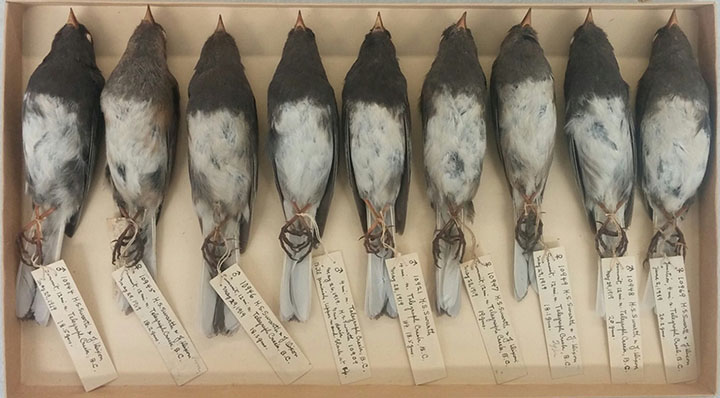Written by Steve Ruskin, a Colorado-based historian and writer. Steve holds a PhD in History and Philosophy of Science from the University of Notre Dame.
In July of 2014 I had the pleasure of corresponding with Christina Fidler of the MVZ archives. I was completing an article for the journal Historical Studies in the Natural Sciences, published by the University of California Press. The article, “The Business of Natural History: Charles Aiken, Colorado Ornithology, and the Role of the Professional Collector,” was recently published in issue 45(3).
Charles Aiken (1850–1936) was a naturalist based in Colorado Springs, Colorado, and was an important American ornithologist at the end of the nineteenth century and into the first part of the twentieth. His bird collection, including many thousands of specimens of birds of the American West (many of which he collected himself), became one of the definitive North American bird collections. He sold specimens to major museums and his bird (and some animal) specimens are still part of the collections of places like the Smithsonian, the American Museum of Natural History, and the University of California’s Museum of Vertebrate Zoology. The bulk of Aiken’s collection is housed in the University of Colorado’s Museum of Natural History.
To facilitate their work and research, naturalists in the nineteenth century had a habit of sending each other specimens through the mail. Sometimes this was to have the specimen identified by an expert. Other times this was to trade one specimen for another in a network of exchange, which furthered the advancement of knowledge of natural history among the discipline’s practitioners.
I mention all of this because I found an interesting correlation between Aiken’s selling and sharing of specimens with museums like the MVZ, and my own correspondence with Christina (who was a real joy to work with, by the way). Christina was sending me scans of correspondence between Aiken and Joseph Grinnell, the MVZ’s first director. In the process, Christina also located some highly relevant correspondence that I was not aware of, between Grinnell and another Colorado Springs naturalist, Edward Warren, who was a colleague of Aiken.
In April 1927, Grinnell had sent Aiken nineteen specimens of junco, a small North American bird, for Aiken to study. Aiken was an expert on the junco; one sub-species of that bird was even named after him. Anyway, Aiken held onto the MVZ’s junco specimens for over a year, and Grinnell was anxious to have them back. He wrote Aiken a few times, but to no avail. So, in desperation, Grinnell wrote to Warren confidentially, asking if Warren would be so kind as to “stimulate the situation” and see if he could get Aiken to return the junco specimens as soon as possible.
Warren did what he could, wandering over to Aiken’s natural history dealership one crisp October morning and gently reminding Aiken that it was about time to send the specimens back to the MVZ. Warren then wrote to Grinnell that Aiken’s shop “is a mighty poor place.” He found insect larva crawling in some specimens (not, apparently, any MVZ material) and other specimens with probable smoke damage, because Aiken “had a fire … last spring and it is wonder the loss was not greater than it was.” Aiken was nearly 80 years old at that point, stubborn and forgetful, and it took more letters and a few telegrams from Grinnell to finally get the specimens returned to the MVZ, over a year and a half after they were first sent.
Coming full circle, this historical episode in the lives of naturalists and their sharing of specimens made me think how fortunate that I, as an historian, have access to the source material I need, even when located in distant archives, by means of technology like the internet and digital scanners, as well as research institutions like the MVZ who are still willing to share material from their collections. However, unlike the process of sharing archival material a century ago, when items were sent across the country and risked being lost, damaged, or forgotten, all Christina had to do was scan copies of letters and telegrams and email them to me, with no concern that I might somehow forget to return them, harm them, or otherwise inconvenience the MVZ.
Of course, I work with written documents, not dead animal skins, so the process is much easier. But as I was writing my article on Aiken, the contrast between the way information was shared then and now, in the early twentieth century—with its chugging trains and postal systems, and the early twenty-first—with the internet and digital imaging technologies, stuck in my mind.
Who knows how technology might continue to change the way specimens are shared? Roughly a decade ago, Harvard began their E-Type Initiative to provide visual access to important type specimens in botany and entomology. But those were to be only high-resolution images. Recently, my local library installed a number of 3D printers for public use. Considering those two projects together made me think that it might not be too much of a stretch to imagine that, if 3D printing continues to advance, it might soon be feasible that a zoologist in Australia could request a “scan” of a specimen from the MVZ and, a few hours later, find a near perfect—if plastic—replica in their 3D printer’s tray.
Now that would be cool.
In conclusion, on behalf of Colorado Springs, let me take this opportunity to offer my belated apology to the MVZ for Aiken’s inconsiderateness almost 90 years ago, and thank them for their generous assistance in my own research on 19th-century natural history.

